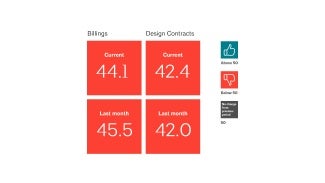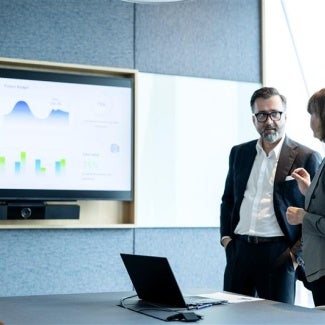ABI March 2025: Business conditions at architecture firms soften further
Firm leaders report that ABI data, interest rates, and firm billings are most useful indicators they track to evaluate the business climate

Business conditions at architecture firms remained quite soft in March.
The ABI/Deltek Architecture Billings Index dipped further from February to 44.1 in March, as even more firms reported a decline in billings from the previous month. Since the ABI first dropped below 50 in October 2022, following the post-pandemic boom, billings have declined 27 of the last 30 months. Unfortunately, this softness is likely to continue as indicators of future work remain weak. Inquiries into new work declined for the second month in March, while the value of newly signed design contracts fell for the thirteenth consecutive month. Clients are increasingly nervous about the uncertain economic outlook, and many remain wary of starting new projects at this time. However, backlogs at architecture firms remain reasonably healthy at 6.5 months, on average, which means that even though little new work is coming in currently, they still have a decent amount in the pipeline.
Firm billings continued to decline in all regions of the country in March as well. Billings were softest at firms located in the Northeast for the sixth consecutive month but also weakened further at firms located in the West and Midwest. Firms located in the South reported the smallest decline in billings. Business conditions also remained weak at firms of all specializations, with firms with a multifamily residential specialization continuing to report the softest conditions. Billings were trending stronger at firms with an institutional specialization late last year but have softened significantly since then.
Consumer confidence falls despite strong hiring and lower inflation
Conditions were mixed in the broader economy in March. Nonfarm payroll employment gains were strong, with 228,000 new positions added, while architecture services employment was flat at 203,300 in February, the most recent data available. Employment in the industry declined in the summer and fall of 2024 but has stabilized recently. In addition, consumer prices declined by 0.1% in March, the largest monthly decrease in nearly five years, led by declines in gas prices, airfare, and lodging away from home. The Consumer Price Index (CPI) increased by just 2.4% from one year ago in March, marking the lowest level of inflation since early in the pandemic. However, despite encouraging job growth and declining inflation, consumer sentiment, as reported in the University of Michigan Index of Consumer Sentiment in early April, declined to a level near the all-time low. Consumers are very concerned about potential future increases in inflation due to newly implemented tariffs. Although many reciprocal tariffs have now been paused for 90 days, there remains a great deal of uncertainty about which tariffs will be implemented and their long-term impact on the economy.
Firm leaders report tracking a variety of business conditions at their firm
In light of recent economic uncertainty, this month we asked firm leaders about the business information they track to evaluate the business climate and business conditions at their firm. Among general business climate indicators, firm leaders reported that the most regularly used indicators include interest rates (53% of firm leaders reported using them regularly), business confidence scores (38% use regularly), and stock market trends (35% use regularly). When asked to select the one most useful business climate indicator of the ones they reported using regularly, 43% selected interest rates, and 24% selected business confidence scores.
Among design/construction industry indicators, more than two-thirds of responding firm leaders (67%) reported using ABI data regularly, while 51% reported tracking the costs of construction materials regularly. Of the design/construction industry indicators they use regularly, 58% of firm leaders selected the ABI as the one most useful indicator, while 23% selected construction materials prices.
Firm leaders are by far most likely to track various measures of business conditions at their firm to monitor the business climate. More than half of firm leaders reported that they regularly use firm billings (95%), firm profitability (84%), firm backlog (77%), individual project profitability (64%), staff chargeability/utilization rates (56%), and employee productivity levels (53%) to monitor business conditions. And while they track many of these firm business conditions regularly, more than four in ten responding firm leaders (41%) selected firm billings as the one most useful business condition to track, followed by firm backlogs (20% selected as the most useful), and firm profitability (15% selected as most useful).
- Join us for FREE at the next AIAU live webinar Economic Update: Q2 2025 ABI Insights on Thursday, May 01, 2025 at 2pm.
This month, Work-on-the-Boards participants are saying:
- “Freeze on federal spending has caused several projects to go on hold.”—143-person firm in the West, institutional specialization
- “Tariffs and immigration policy are having a serious dampening effect on projects, as costs increase significantly.”—125-person firm in the Northeast, mixed specialization
- “Weak. Private clients are waiting to see; government-funded projects are disappearing.”—3-person firm in the South, commercial/industrial specialization
- “Now up to three projects impacted by federal budget cuts ($1.5 million in lost revenue), which causes uncertainty.”—23-person firm in the Midwest, institutional specialization
Join the ABI Work-on-the-Boards panel to participate in our monthly survey. Open to architecture firm owners, principals, and partners. All participants get a free ABI subscription.
The monthly AIA/Deltek Architecture Billings Index is a leading economic indicator for nonresidential construction activity.
Deltek is the home of AIA MasterSpec®, powered by Deltek Specpoint. Deltek helps A&E firms boost efficiencies while improving collaboration and accuracy.













